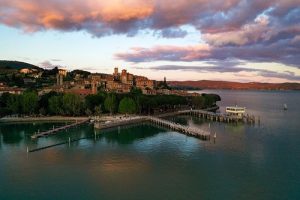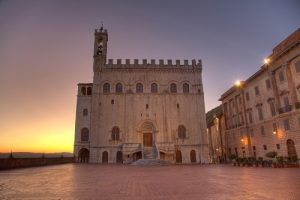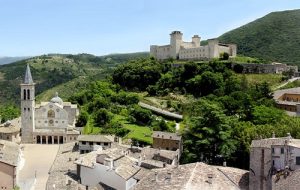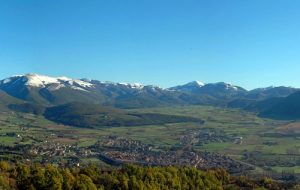Written by Umbra Rep Timothy Ringie, University of Massachusetts – Amherst
I’ve always had a pretty strong idea of what I wanted my study abroad experience to look like. I knew that I wanted an experience other than one in a large city such as Florence, Rome, or Milan where I’d be surrounded by hundreds of other American and English speaking students and tourists. I wanted the opportunity to practice my Italian and not be able to solely rely on my English in everyday life. In order to do that however, I knew I needed to find a program away from popular destinations and to find one that would provide true immersion into Italian culture.
As I departed the US for the Umbra Institute, the one thing that concerned me most was that I was sacrificing the opportunity to enjoy a vibrant nightlife. It’s not that I was expecting zero nightlife in Perugia, it was just that I assumed it would be vastly different, and on a much smaller scale, than what I would have experienced in Florence or Rome. Wow, I could not have been more mistaken!
During my first weekend here in Perugia, I saw a side of the city I was not expecting. Granted, the population here (160,000 give or take) is far less than that in Rome or Florence, so the nightlife options are less numerous. I believe, however, that this works in Perugia’s favor. Something that I wasn’t aware of before arriving in Perugia was the amount of students that can be found here. The Umbra Institute is just a small part of the overall student body here in the city. Besides the Umbra Institute, there are somewhere around 40,000 students, broken up between the Università degli Studi di Perugia (the Italian University) as well as the Università per Stranieri di Perugia (the University for Foreigners). That means that in addition to a large number of Italian students, there are students here from all over the world as well.
During my first weekend here, I was astounded at what I saw; when I left my apartment at night, the first thing that hit me was the noise. Normally on Via dei Priori, the street which I live on, is not loud at all. The street is lined with shops and restaurants so there are usually a lot of people out and about but not like this. I was greeted by group after group of people making the long walk up the steep hill toward the city center. As I walked up the street, it just kept getting louder and louder. Doorways which seemed unassuming during the day opened up and there were crowds of dozens and dozens hanging around and chatting. As I neared the top of the street, I ran into a literal wall of people, who were all crowding around the entrance of a popular bar called “Gold Bar”. As I made my way through the maze of people, rattling off “mi scusi” and “permesso”, the noise just got louder. I rounded the corner and I looked towards the main square Piazza IV Novembre, I caught a glimpse of what my weekends would be looking like for the next few months. There were literally thousands of people in the square, all congregated in large and small groups. I had certainly not expected such a vibrant nightlife and that was only a taste of what was to come!
As I got more settled into life in Perugia, I began to understand the “nightlife habits” of the Italians as well as the fun spots to go to in Perugia. One thing I noticed is that compared to the United States, everything starts later here in Italy. Aperitivo, which serves as a sort of appetizer to dinner where you meet up and chat with friends, occurs around 6-8pm. Along the Corso Vannucci, the “main street”, there are restaurants set up outdoor seating in the middle of the street which creates a very lively atmosphere. Italians usually don’t start eating dinner until around 8pm and there is no shortage of great restaurants to choose from. After dinner, everybody takes to the streets and before you know it, the streets and piazzas are completely full of people.
Everyone uses the Piazza IV Novembre as a meeting point to decide where to go. Maybe you’ll decide to make the quick walk just past the cathedral to Dempsey’s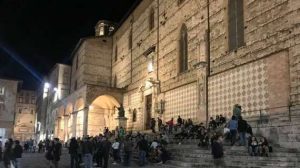 bar, an American-owned bar which always has a huge ground outside, but even though it’s an American bar, there is no shortage of Italians outside. Or maybe you’ll decide to walk around the corner to Marla’s, a two-floored bar which normally hosts live music. There are also plenty of great areas away from the main piazza and great spots to practice your Italian the further you go from the piazza as they are where the locals tend to hang out. Streets like Corso Cavour and Via della Viola are great areas to interact with the locals. Via della Viola, with fun places like C’era una Vodka or Agricola, is very interesting as you can hear street musicians playing well into the late hours of the night. But watch out as you may have to squeeze to the sides of the street every once in a while as an unfortunate driver tries to navigate through the crowds of people! If you’re into dancing, maybe you’ll visit one of the few discotecas right outside the city, although I personally haven’t visited them as nobody wants to see my dance moves. Or better yet, you may even run into some of the Umbra Institute staff at Elfo’s Pub right off of Via dei Priori collectively enjoying a soccer match on the large projector there. There is no shortage of great venues and spots for all here in Perugia.
bar, an American-owned bar which always has a huge ground outside, but even though it’s an American bar, there is no shortage of Italians outside. Or maybe you’ll decide to walk around the corner to Marla’s, a two-floored bar which normally hosts live music. There are also plenty of great areas away from the main piazza and great spots to practice your Italian the further you go from the piazza as they are where the locals tend to hang out. Streets like Corso Cavour and Via della Viola are great areas to interact with the locals. Via della Viola, with fun places like C’era una Vodka or Agricola, is very interesting as you can hear street musicians playing well into the late hours of the night. But watch out as you may have to squeeze to the sides of the street every once in a while as an unfortunate driver tries to navigate through the crowds of people! If you’re into dancing, maybe you’ll visit one of the few discotecas right outside the city, although I personally haven’t visited them as nobody wants to see my dance moves. Or better yet, you may even run into some of the Umbra Institute staff at Elfo’s Pub right off of Via dei Priori collectively enjoying a soccer match on the large projector there. There is no shortage of great venues and spots for all here in Perugia.
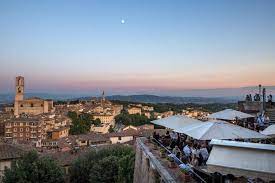 Despite all these great places I’ve mentioned, they’ve not been the most memorable part of the nightlife for me here in Perugia. The most memorable for me by far, has been the people. What makes Perugia fundamentally different from a larger city, is the fact that you really feel like a part of the city and community. I have had the wonderful opportunity to meet people from around the world here, not just from Italy but from countries far and wide like Canada, Spain, France, Russia, South Africa, Germany and more. Perugia feels like a melting pot where everyone is open to meeting new people. In larger cities, people are often wary of those they don’t know and will only stick to their friend group. Here in Perugia I’ve found myself engaging in conversations with people from different countries and cultures, with widely different ages and backgrounds. The people here are excited to meet new people and hear their stories.
Despite all these great places I’ve mentioned, they’ve not been the most memorable part of the nightlife for me here in Perugia. The most memorable for me by far, has been the people. What makes Perugia fundamentally different from a larger city, is the fact that you really feel like a part of the city and community. I have had the wonderful opportunity to meet people from around the world here, not just from Italy but from countries far and wide like Canada, Spain, France, Russia, South Africa, Germany and more. Perugia feels like a melting pot where everyone is open to meeting new people. In larger cities, people are often wary of those they don’t know and will only stick to their friend group. Here in Perugia I’ve found myself engaging in conversations with people from different countries and cultures, with widely different ages and backgrounds. The people here are excited to meet new people and hear their stories.
After having been two and a half months here in Perugia, I seldom go out on a weekend without running into someone who I’ve had a conversation with at some point or another. It’s a really nice feeling when someone you have met from another country remembers your name! Perugia is the best of both worlds when it comes to the nightlife; it is big and diverse enough that there are plenty of options in terms of a night life for those who want it, but it is also small enough to provide awesome opportunities to make connections with the city and the people and form real friendships.


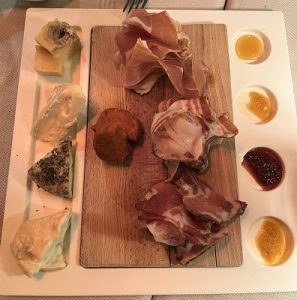 Antipasti
Antipasti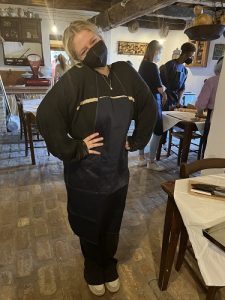 Secondi
Secondi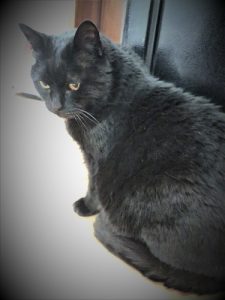
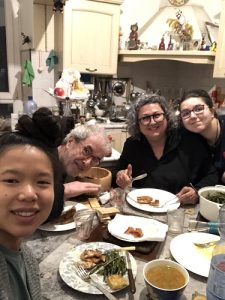
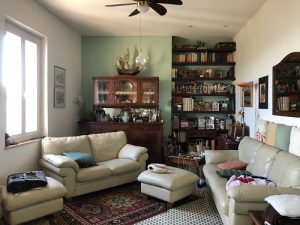
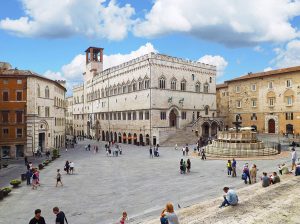
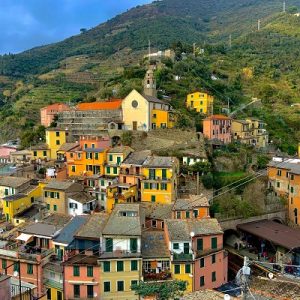
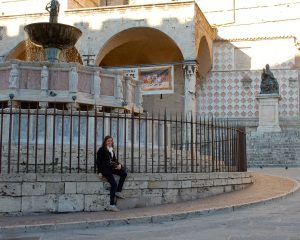
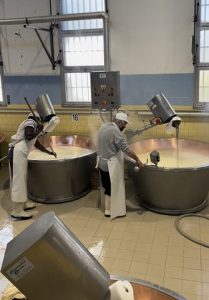 In this factory, we were able to see the milk being warmed, whey being separated, the cheese separating from the milk, the drying room, rein making room, and the aging room. For some reason, seeing the whole entire process makes you feel like you have a stronger connection with the cheese. Instead of mindlessly looking for the name, Parmigiano Reggiano, in the food store, you can look at it and know all the thought that has gone into making a small triangle of cheese. Not only does seeing the process make you have a greater appreciation for the cheese, but understanding that the techniques used to make the cheese today have been the same for many years. There is a long line of hands, minds, and hearts that have carefully considered each technique to make this certain type of cheese in this area. More specifically thinking, the salting room of the factory is where the cheese soaks in order to absorb the salt to preserve it and make the rein. This technique has been used since the Middle Ages and continues today.
In this factory, we were able to see the milk being warmed, whey being separated, the cheese separating from the milk, the drying room, rein making room, and the aging room. For some reason, seeing the whole entire process makes you feel like you have a stronger connection with the cheese. Instead of mindlessly looking for the name, Parmigiano Reggiano, in the food store, you can look at it and know all the thought that has gone into making a small triangle of cheese. Not only does seeing the process make you have a greater appreciation for the cheese, but understanding that the techniques used to make the cheese today have been the same for many years. There is a long line of hands, minds, and hearts that have carefully considered each technique to make this certain type of cheese in this area. More specifically thinking, the salting room of the factory is where the cheese soaks in order to absorb the salt to preserve it and make the rein. This technique has been used since the Middle Ages and continues today.  Furthermore, there is a very special “passing of the baton” with the “cheese master”. From the past and to the present, there is a person that is known to be so skilled in knowing if the quality of the milk and cheese is good just by running their fingers through the clumps after the rennet is added. Typically, this is an older man. In the past, before jobs were not as labor intensive, an entire family could be working in the cheese factory. One person could be milking the cows, stirring the whey, adding the rennet, or shaping the cheeses. Normally the elder of the family, or the person with the most wisdom of the cheese, is granted the most respected position of the “cheese master”. This person knows the cheese so well that they can tell if it is perfect just by seeing, smelling, and touching it. This “passing of the baton” has since faded, but adds to the value of the making of cheese and the history behind the factory. It is not only a group of people who are passionate about food and cheese, but a family who is close enough to work together and share their family’s love for cheese with the rest of the world.
Furthermore, there is a very special “passing of the baton” with the “cheese master”. From the past and to the present, there is a person that is known to be so skilled in knowing if the quality of the milk and cheese is good just by running their fingers through the clumps after the rennet is added. Typically, this is an older man. In the past, before jobs were not as labor intensive, an entire family could be working in the cheese factory. One person could be milking the cows, stirring the whey, adding the rennet, or shaping the cheeses. Normally the elder of the family, or the person with the most wisdom of the cheese, is granted the most respected position of the “cheese master”. This person knows the cheese so well that they can tell if it is perfect just by seeing, smelling, and touching it. This “passing of the baton” has since faded, but adds to the value of the making of cheese and the history behind the factory. It is not only a group of people who are passionate about food and cheese, but a family who is close enough to work together and share their family’s love for cheese with the rest of the world.  I learned after I entered that the only way to see the sets is to go through an hour and a half tour, but there are only two tours in English, at 11:30, Saturday and Sunday. Not knowing this, I got there at 12:05, just missing the English tour, so I went on the Italian one at 12:30. Here I was fully immersed in the Italian language, no use of google translate or by standards could help translate for me, so auditorially I couldn’t understand what was happening. But looking at the sets, walking through Italian history I was immersed in the past, completely immersed in what the sets once meant. I loved walking through the sets knocking on everything I passed as what looks so real, was completely hallow, fooling millions of viewers and countless patrons visiting the sets.
I learned after I entered that the only way to see the sets is to go through an hour and a half tour, but there are only two tours in English, at 11:30, Saturday and Sunday. Not knowing this, I got there at 12:05, just missing the English tour, so I went on the Italian one at 12:30. Here I was fully immersed in the Italian language, no use of google translate or by standards could help translate for me, so auditorially I couldn’t understand what was happening. But looking at the sets, walking through Italian history I was immersed in the past, completely immersed in what the sets once meant. I loved walking through the sets knocking on everything I passed as what looks so real, was completely hallow, fooling millions of viewers and countless patrons visiting the sets. 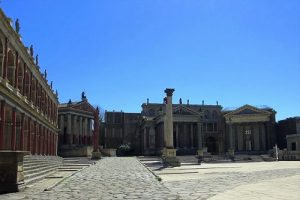 I proceeded to walk around the grounds and go to the museum on site. The museum is filled with facts about how a film is made, costumes from films, and parts of the history of Cinecittà. The spectacular nature of Cinecittà sent me down a deep dive into its historical nature. It was originally created by Benito Mussolini in 1936-1937, as a way for the fascist government to control the Italian film industry, and help shape a more fascist society. After all, Mussolini once said “Cinema, the strongest weapon” understanding the power film had in culture. But after the Allies won World War II the facility was closed, which allowed for the spread of Neorealism (Neorealist films were often filmed on location rather than in sets which allowed for a more authentic representation of Italian civilization.) It was until the 1950s, that the sets were rebuilt and opened for use. For roughly 20 years Cinecittà sets held some of the most famous Italian directors and very prominent Hollywood films. However, as television grew, the quality of films coming out of Cinecittà declined. As a result, the studio became obsolete. In recent years, Cinecittà has been used to film Italian television shows, but it is mostly used as a museum, an homage to the Golden Age of Italian Cinema. For any film enthusiasts, I highly suggest the short train ride to Cinecittà, attend the English-speaking tour, and fill me in on what I missed.
I proceeded to walk around the grounds and go to the museum on site. The museum is filled with facts about how a film is made, costumes from films, and parts of the history of Cinecittà. The spectacular nature of Cinecittà sent me down a deep dive into its historical nature. It was originally created by Benito Mussolini in 1936-1937, as a way for the fascist government to control the Italian film industry, and help shape a more fascist society. After all, Mussolini once said “Cinema, the strongest weapon” understanding the power film had in culture. But after the Allies won World War II the facility was closed, which allowed for the spread of Neorealism (Neorealist films were often filmed on location rather than in sets which allowed for a more authentic representation of Italian civilization.) It was until the 1950s, that the sets were rebuilt and opened for use. For roughly 20 years Cinecittà sets held some of the most famous Italian directors and very prominent Hollywood films. However, as television grew, the quality of films coming out of Cinecittà declined. As a result, the studio became obsolete. In recent years, Cinecittà has been used to film Italian television shows, but it is mostly used as a museum, an homage to the Golden Age of Italian Cinema. For any film enthusiasts, I highly suggest the short train ride to Cinecittà, attend the English-speaking tour, and fill me in on what I missed. 